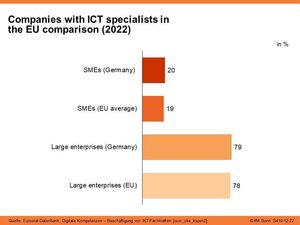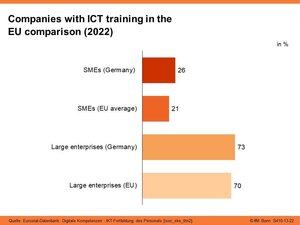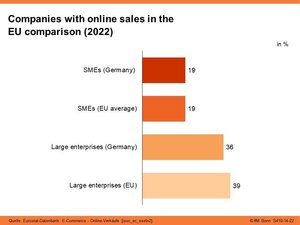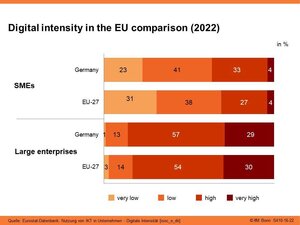Mittelstand - Themes
The IfM Bonn presents quantitative data on small and medium-sized enterprises (SME definition of the IfM Bonn) and large companies on the following pages. The data is updated regularly. In addition, the IfM Bonn also presents information on SMEs in the European context.
Please note that we currently provide only a selection of the most important statistics on our English website.
The Covid-19 pandemic showed the opportunities of digital transformation even for small and medium sized enterprises (SME) have. However, existing statistical data indicate significant disparities in both technological and human resource capabilities for implementing digitalization, both among SMEs and between SMEs and large enterprises in the European context.
SME employ fewer ICT specialists
In Germany, about one-fifth of all SMEs employ specialists with advanced knowledge about Information and Communication Technology (ICT). These figures are slightly above those from 2020 and are in line with the averages in the EU. However, a lot more ICT-specialists are employed in large enterprises compared to SMEs, both in Germany and across the EU. But differences can even be observed between different SME categories: about 47% of medium-sized enterprises in Germany have staff with ICT competencies, whereas among small enterprises, the figure is only 15%.
Increase in SMEs Providing ICT training
In 2022, 26% of SMEs in Germany provided ICT training for their employees, more than EU-average (21%). Compared to the first year of the pandemic 2020, this is a 4-percent increase. However, this does not compensate for the significant 8-percent decrease due to the pandemic. Additionally, ICT-training in SMEs is considerably weaker than the training in large enterprises.
Proportion of Companies Engaged in Online Sales Remains Stable
The proportion of companies, which make at least 1% of their turnover through online sales, has remained relatively stable compared to the previous year: Among SMEs, this figure increased from 18& to 19% across the EU but stayed constant at 19% in Germany. However, among large enterprises in Germany, the proportion of companies engaged in online sales decreased 2% in 2022 compared to the previous year, falling below the EU average of 39%.
Increasing Digital Intensity of SMEs
The digital intensity of SMEs in Germany is higher than EU average. 37% of German SMEs reported having “high” and “very high” digital intensity, whereas the the EU-wide figure was only 31%. In contrast large enterprises in Germany showed little differences in their digital intensity compared to large enterprises in the rest of the EU. However, digital intensity increases with the size of the enterprise.
Tables on Digitalization of SMEs in the EU Comparison
Select a characteristic and the desired differentiation! The corresponding table is available as a pdf file.
| Characteristics | distinction | |||
|---|---|---|---|---|
| Usage of ICT in Companies | WebS | WerbPay | DSL-BB | DigInt |
| Digital Competencies | IKT-Besch | FortbPers | ||
| E-Commerce | Online-EK | Online-VK | ||
| E-Business | BD | CC | 3D-Dr | ROB |
WebS = Website; WerbPay = Paid Advertising; DSL-BB = DSL/Broadband Access; DigInt = Digital Intensity; IKT-Besch = ICT Employees; FortbPers = ICT Training for Personnel; Online-EK = Online Purchases; Online-VK = Online Sales; BD = Big Data; CC = Cloud Computing; 3D-Dr = 3D Printing; ROB = Industrial or Service Robots
Update
Data for the year 2023 is expected to be available in early 2024.
Additional information about the data source
Contact person
Research coordinator Christian Schröder
- Telephone
- +49 228 7299743
- Get in contact



